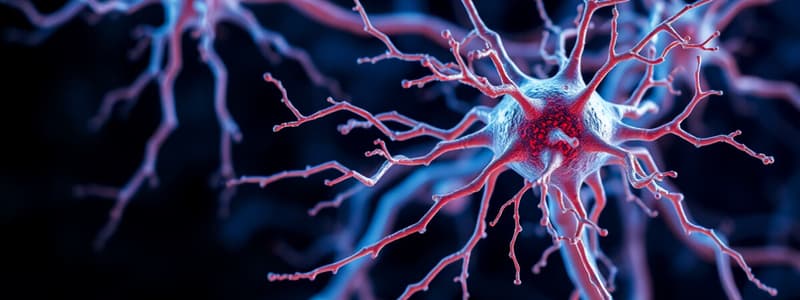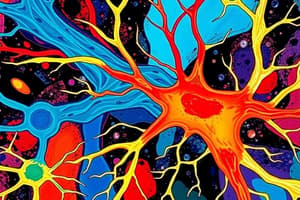Podcast
Questions and Answers
What primary function does the nervous system serve in the body?
What primary function does the nervous system serve in the body?
- Structural support and movement.
- Communication and coordination. (correct)
- Regulation of body temperature.
- Nutrient absorption and distribution.
A person walking on a tightrope makes constant adjustments to their posture to maintain balance. Which component of the nervous system is primarily responsible for these rapid adjustments?
A person walking on a tightrope makes constant adjustments to their posture to maintain balance. Which component of the nervous system is primarily responsible for these rapid adjustments?
- Tear glands
- The Spinal cord
- The autonomic nervous system
- Vestibular receptors (correct)
The central nervous system (CNS) is protected by:
The central nervous system (CNS) is protected by:
- Spinal nerves and cranial nerves.
- Peripheral nerves only.
- Peripheral nerves
- The skull and the vertebral column. (correct)
If dust particles enter the eye, the nervous system signals the tear glands to produce tears. Which type of signal transmission is demonstrated in this scenario?
If dust particles enter the eye, the nervous system signals the tear glands to produce tears. Which type of signal transmission is demonstrated in this scenario?
What role do cranial nerves play in the organization of the nervous system?
What role do cranial nerves play in the organization of the nervous system?
How do the sympathetic and parasympathetic nervous systems interact to maintain homeostasis?
How do the sympathetic and parasympathetic nervous systems interact to maintain homeostasis?
Which of the following accurately describes the primary function of the somatic nervous system?
Which of the following accurately describes the primary function of the somatic nervous system?
Which function is NOT directly controlled by the autonomic nervous system?
Which function is NOT directly controlled by the autonomic nervous system?
What is the main role of the sympathetic nervous system during a dangerous situation?
What is the main role of the sympathetic nervous system during a dangerous situation?
What is the longitudinal fissure's role in the structure of the brain?
What is the longitudinal fissure's role in the structure of the brain?
How do the meninges and cerebrospinal fluid protect the brain?
How do the meninges and cerebrospinal fluid protect the brain?
Which part of the brain is primarily responsible for coordinating movement?
Which part of the brain is primarily responsible for coordinating movement?
What would be the likely outcome if a person has damage to their cerebellum?
What would be the likely outcome if a person has damage to their cerebellum?
What is the primary role of the thalamus in processing sensory information?
What is the primary role of the thalamus in processing sensory information?
Which of the following describes the hypothalamus' function?
Which of the following describes the hypothalamus' function?
Which vital functions are regulated by the brainstem?
Which vital functions are regulated by the brainstem?
Which function is most closely associated with the limbic system?
Which function is most closely associated with the limbic system?
What is the main function of the spinal cord?
What is the main function of the spinal cord?
Which statement best describes how myelination affects nerve impulse transmission?
Which statement best describes how myelination affects nerve impulse transmission?
What is the primary role of sensory neurons?
What is the primary role of sensory neurons?
What is the role of interneurons in the nervous system?
What is the role of interneurons in the nervous system?
What is the 'resting potential' of a neuron primarily determined by?
What is the 'resting potential' of a neuron primarily determined by?
What happens during depolarization of a neuron?
What happens during depolarization of a neuron?
What role do neurotransmitters play in synaptic transmission?
What role do neurotransmitters play in synaptic transmission?
What is the function of the synapse in the nervous system?
What is the function of the synapse in the nervous system?
Flashcards
Nervous System
Nervous System
The body's communication and coordination network, constantly alive with electricity.
From Stimulus to Reaction
From Stimulus to Reaction
Impulses conducted from receptors to muscles, allowing posture adjustment.
Nerves
Nerves
Nerve cells or neurons forming the nervous system.
Central Nervous System (CNS)
Central Nervous System (CNS)
Signup and view all the flashcards
Peripheral Nervous System (PNS)
Peripheral Nervous System (PNS)
Signup and view all the flashcards
Spinal Nerves
Spinal Nerves
Signup and view all the flashcards
Cranial Nerves
Cranial Nerves
Signup and view all the flashcards
CNS and PNS function
CNS and PNS function
Signup and view all the flashcards
Autonomic Nervous System
Autonomic Nervous System
Signup and view all the flashcards
Somatic Nervous System
Somatic Nervous System
Signup and view all the flashcards
Sympathetic System
Sympathetic System
Signup and view all the flashcards
Parasympathetic System
Parasympathetic System
Signup and view all the flashcards
The Brain
The Brain
Signup and view all the flashcards
Meninges
Meninges
Signup and view all the flashcards
Cerebral Cortex
Cerebral Cortex
Signup and view all the flashcards
Frontal Lobe
Frontal Lobe
Signup and view all the flashcards
Parietal Lobe
Parietal Lobe
Signup and view all the flashcards
Temporal Lobe
Temporal Lobe
Signup and view all the flashcards
Occipital Lobe
Occipital Lobe
Signup and view all the flashcards
Cerebellum
Cerebellum
Signup and view all the flashcards
Brainstem
Brainstem
Signup and view all the flashcards
Limbic System
Limbic System
Signup and view all the flashcards
Spinal Cord
Spinal Cord
Signup and view all the flashcards
Sensory Neurons
Sensory Neurons
Signup and view all the flashcards
Motor Neurons
Motor Neurons
Signup and view all the flashcards
Study Notes
- The nervous system constantly uses electricity to coordinate communication in the body.
The Extent of the Nervous System
- Individual nerves joined could wrap around the world 2.5 times.
Stimulus and Reaction
- Well-coordinated muscle action is necessary for balance, and the nervous system uses receptors to send impulses to the effectors.
Nervous System as a Conductor
- It sends impulses to muscles and glands, reacting to stimuli like dust or onion smells, causing the eyes to tear.
Organization of the Nervous System
- The nervous system contains nerves made up of nerve cells, also called neurons, with about 100 billion in the body.
- Most are in the brain and spinal cord, which are part of the central nervous system (CNS), where the brain processes information, and the spinal cord connects the brain to the body.
- The skull protects the brain, and the vertebral column protects the spinal cord.
Peripheral Nervous System (PNS)
- Made up of peripheral nerves sends messages from the brain and spinal cord to control limb movement.
- Spinal nerves enter or leave the spinal cord; cranial nerves enter or leave the brain.
- Peripheral nerves also send sensory information to the CNS.
CNS and PNS
- Transmit and process information, coordinating bodily functions and carrying electrical signals.
- The brain and spinal cord act as a control center, receiving and sending data.
Classification by Function:
- The nervous system includes the autonomic nervous system, which controls involuntary functions, and the somatic nervous system, which transmits sensory information and motor commands to skeletal muscles.
Autonomic vs Somatic Nervous System
- The autonomic system is divided into sympathetic (arousing) and parasympathetic (calming) systems.
- The somatic system includes sensory (afferent) and motor (efferent) systems.
PNS Divisions
- The PNS has the autonomic nervous system for unconscious control and the somatic nervous system for sensory information and motor commands.
Somatic Nervous System
- Made of cranial and spinal nerves, contains sensory and motor neurons, transmitting sensory information and motor messages through the CNS.
Autonomic Nervous System
- Changes autonomic body functions like respiration, circulation, and temperature.
- It's divided into sympathetic (fight or flight) and parasympathetic (resting state) systems.
Sympathetic Nervous System
- The sympathetic nervous system prepares the body for danger, triggering responses like increased heart rate and inhibited digestion.
Parasympathetic Nervous System
- The parasympathetic nervous system helps the body "rest and digest", resetting organ functions after sympathetic activation.
Brain Function
- The brain resembles a computer but possesses complex development, learning, emotion, and creativity.
Brain Signals
- The brain passes millions of signals through its network every second.
Brain Structure
- The longitudinal fissure divides the brain into 2 hemispheres protected by meninges.
- Ventricles produce cerebrospinal fluid for shock absorption and protection.
Brain Components
- Three major parts that make up the brain: cerebrum, cerebellum, and brainstem.
- The cerebral cortex lies on top of the cerebrum, while the thalamus and pituitary gland are located below the corpus callosum.
Thalamus Function
- Coordinates sensory information.
Hypothalamus Function
- The hypothalamus is a gland that handles nervous and hormonal system communication, and the pituitary gland is the master gland.
Spinal Cord/Brain Function
- The brain and spinal cord control both conscious and unconscious processes, enabling thought.
Matter in Brain
- White matter is the inner structure bringing information to the cerebral cortex, while gray matter is the outer later where processing occurs. This effects vision, hearing and reaction.
Cerebral Cortex Makeup
- White matter is buried, and grey matter is on the surface in equal parts.
Cerebral Cortex Structure
- The cortex is split into left and right hemispheres, each with four lobes: frontal, parietal, temporal, and occipital.
- The lobes specialize in areas such as thought, memory, planning, speech, etc.
Frontal Lobe
- Contains the olfactory bulb for processing smells and the motor cortex for planning movement.
- Areas relates to muscle groups that correlate to cognitive functions like attention, speech, and decision-making.
Parietal Lobe
- Processing of somatosensation (touch, pain, heat, cold) and proprioception.
Temporal Lobe
- Processes and interprets sounds and contains the hippocampus for memory formation.
Occipital Lobe
- Primarily involved in vision; seeing, recognising, and identifying the visual world.
Cerebellum Properties
- The cerebellum is the second-largest part containing more neurons, with left and right hemispheres connected by the vermis.
Cerebellum
- Coordinates movements, checks if cerebrum movements reach their target, and learns implicitly to coordinate balance precisely.
Cerebellum and Procedural Memory
- The cerebellum performs tasks that call on procedural memory, such as tying a shoe or riding a bicycle.
Thalamus
- Thalamus serves as "sorting station" for sensory data.
- It relays data from the brainstem towards the cerebral cortex and helps filter out background noise for cognitive functions.
Glands
- The hypothalamus and pituitary gland both produce hormones influencing each other, and control the endocrine system.
Brainstem Definition
- Connects the spinal cord and cerebellum to regulate vital functions.
Brainstem Operations
- Nerve fibres cross over; damage causes brain death; parasympathetic system departs.
Limbic System Properties
- Regulates emotions, behaviors, and memory.
Limbic Functions
- Processes memory, olfaction, and emotions.
Brain Facts
- Average human brain weight of 1.1-1.5 kilograms, 60% fat, approximately 73% water, making up just 2% of total body weight.
- It contains over 86 billion neurons with a high amount of synaptic connections, a 3:1 ration relative to cortex cells.
Spinal Cord
- Connects the brainstem and extends down through the vertebral column.
- Contains nerve tissue for bodies that carry signals to and from the body.
- The spinal cord is connected with spinal nerves (peripheral nervous system).
Functions of the Spinal Cord Structure
- Spinal fluid protects from shocks and transports nutrients.
- Ascending tracts deliver sensory input, descending tracts carry motor commands, containing white matter with a grey butterfly shape.
Peripheral Nervous System Details
- Humans have 12 cranial nerve pairs that connect receptors and the brain, plus motor nerves.
- It also has 31 spinal nerve pairs arriving in or departing from the spinal cord which connect to muscles, glands and organs.
Neurons Composition
- Nervous system contains the nervous system that allow neurons to communicate for certain behavior.
Neuron Traits
- Neurons include a cell body with a nucleus containing DNA. It is surrounded by dendrites and an axon with a axon terminal, at a area called synapses where other cells connect called glial cells.
Glial Cells functions
- Glial cells perform help guide neuron activity and respond to nerve messages by insulating axons and moderating other communications.
Neuron Types:
- Nerve cells are classified into three types.
Sensory Neurons
- Detect and transmit signals from the environment to the central nervous system (CNS).
Types of Neurons
- Sensory neurons are also known as afferent neurons.
- Motor neurons transmits signals from the CNS to the muscles and are known as efferent neurons.
- Interneurons act as connectors between sensory and motor nerve cells.
Motor Neurons
- Motor neurons starts/ controls muscle movements.
Electrical Nerve Impulse Transmission
- A neuron's cell membrane contains electrically charged particles and have membrane potential that allows stimulus.
Electrical Nerve Transmission
- Resting potential is disturbed by electrical signals that lead to depolarization of the axon creating action potential and reversing at 1+ ms.
Signal Speed
- Neurons with myelin sheaths action potentials jump and transmit impulses faster.
Chemical Synaptic Transmission
- A synapse is where information is transmitted from one neuron to another formed axon terminals or dendric spines to other Synapses.
- A neuron transmitting the siognal os called presynaptic and ones that recieves are postsynaptic.
Neurotransmitters details
- When action potentials reaches axons release neurotransmitters that travel to certain cells to stiumlate and inhibit signals.
- In a electric charge where action potentials reach and trigger Na+ it channels to open, depolarizing the presynaptic membrane and open C2+ channels to iniate signalling. vesicles release them towards the neuron to the posynaptic and bind allowing changed to create action.
Neurotransmitters
- Acetylchlorine, epinephrine, dopamine, GABA and serotonin are common.
Neurotransmitters functions
- Stimulate body and are excitatory and inhibitory for different signals.
Voluntary Movements
- The photoreceptors in the eyes register a stimulus, transmit to the vision center in the cerebral cortex, then to the cerebellum, and finally to spinal cord motor neurons for muscle response, which makes your hand lift a book after seeing it.
Reflexes
- Signals demand a quick, spinal cord-directed response to protect to stimuli and connect directly to motor fibers.
Studying That Suits You
Use AI to generate personalized quizzes and flashcards to suit your learning preferences.





